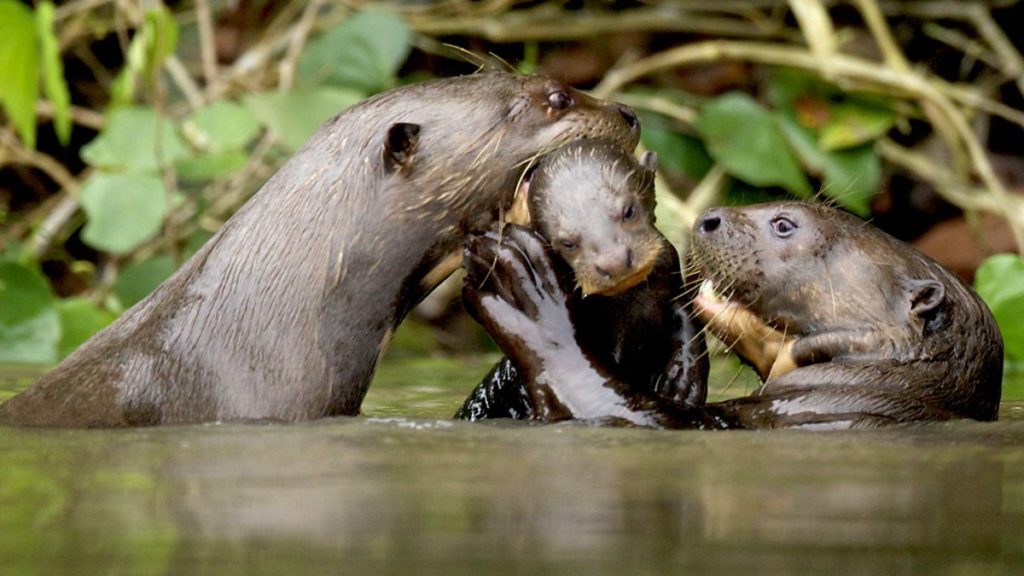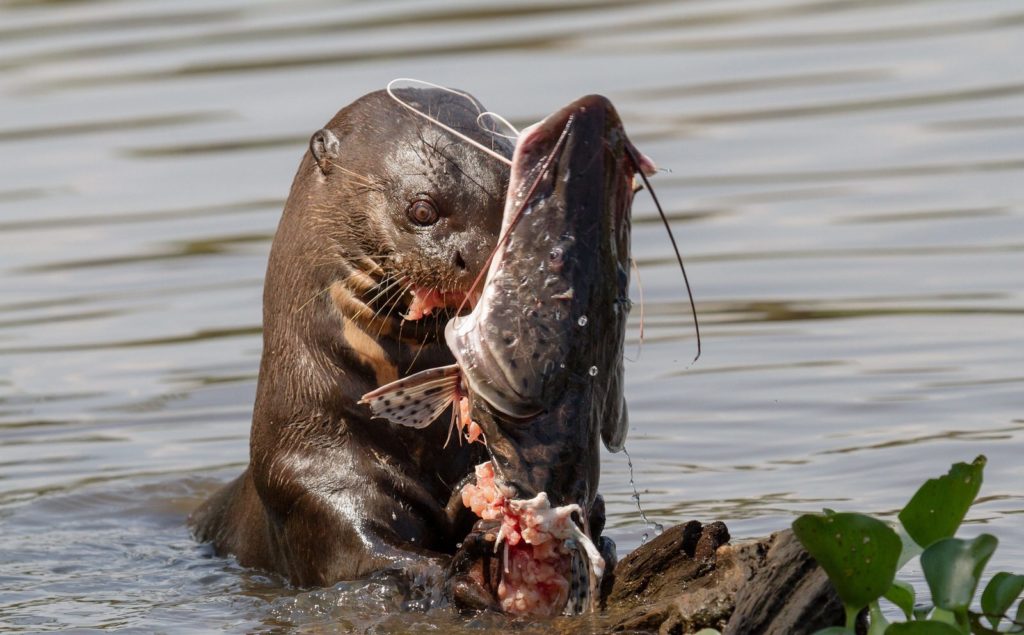IT’S 4.30am, dark and hot, on a late November morning. Needles of rain are bouncing off black water and a tree floats by. But wildlife cameraman Charlie Hamilton James has only one thing on his mind as his small boat putters across the fast-flowing River Manu in the Peruvian Amazon. Five days after leaving England, he has reached his destination – a wooden raft in the middle of a large oxbow lake called Cocha Salvador. As grey light seeps across the sky, the expanse of water on which Charlie is floating becomes distinct from the forested banks. The humidity starts rising sharply. Manu National Park, the most biodiverse place on Earth, begins to wake up.

A black caiman cruises silently past, eyes level with the surface, barely visible bumps atop long toothed jaws. Macaws stir and call, and rainforest insects chirp and hum – noises Charlie has not heard for 10 years. He is still waiting for the sounds that he travelled all this way for. Suddenly, the still air erupts into whistles, sliding-scale squeals and energetic banter. The caiman sinks, the water closing over the top of its head, leaving no trace of the animal’s 2.5m-long bulk. For now, the reptile exits stage left among the overhanging bankside vegetation as the lake’s resident ‘mob’ appears centre stage.
OTTER OBSESSION
Here, at last, is the family that Charlie has waited so long to see again: a boisterous gang of giant otters, each up to 1.8m long, with sleek bodies, seal-like heads and huge webbed feet. They dive, leap and raise their heads high above the surface, peering curiously to see who is on their lake. As Charlie’s camera whirls into action, he can’t help smiling. He has been obsessed with otters for most of his life, and, as his wife and fellow film-maker, I have shared a decade of this passion.

The European otter that Charlie and I have got to know so well is playful, inquisitive and supremely adapted to an aquatic life – but that’s where any similarity with its Amazonian cousin ends. The otter that lives along rivers and coasts is usually secretive and, on the whole, solitary and nocturnal – behaviour that is a world away from the complex sociality displayed by this group of exuberant monsters. Europe’s otters seem modest by comparison – cute, even – whereas these brutes are hardly beautiful to most human eyes. In all honesty they have faces only their mothers could love.
DIABLO’S CLAN
Charlie studies each of the lake’s giant otters in turn. Ever since he filmed this family a decade ago, he has wondered what became of it – in particular, a youngster known as Diablo. He was just a cub then, and Charlie had witnessed his first swim. Had he survived to adulthood? Giant otters have one key distinctive feature -a creamy patch under the chin, the shape of which is unique to each animal. Charlie had memorised the pattern on Diablo’s throat; as he sees an otter swimming across the lake, he’s certain that he is looking at the same individual.
Diablo is clearly now the dominant breeding male of a large clan consisting of himself and his mate Sophia, two cubs from the previous spring, plus five other adults and sub-adults. They all defer to Diablo – he’s the boss. Diablo’s family is the subject of the longest-running study of giant otters, started by Frankfurt Zoological Society (FZS) in 1990. So you might think that we’ve learned pretty much all there is to know about these charismatic mustelids. But Diablo has kept a few surprises for Charlie.
As he watches this first morning, he notices that Diablo’s family seems protective of its den, and it soon becomes apparent why. Not two or even three, but six tiny cubs emerge. They are already a few weeks old, so must have been born in October. In Manu, giant otters usually bear two to four cubs, generally between April and July, so to find so many young at this time of year is completely unexpected. Six cubs! Is that a record? Dr Rob Williams, who leads the FZS research project, is intrigued. “It means that the family has produced two litters of cubs this year,” he says. “On a couple of occasions, we suspected that this was happening, but we’ve never been able to prove it – until now.”

The forest is often impassable in November, which is the rainy season, so the researchers tend to visit Cocha Salvador several months later, when they usually expect to find two or three cubs. Charlie’s discovery suggests that the otters give birth to more young than they had thought and that, by the time the zoologists arrive, only two or three survive. “The cubs are almost certainly being taken by caiman,” Rob muses.
SWIMMING LESSONS
Over the next six months, Charlie films the cubs every day as they discover how to survive in a lake that’s home to 700 hungry caiman. First, they must learn to swim – essential, you might think, but giant otter cubs don’t much like water. One cub in particular – Dali, the smallest of the litter – hates it. Every time his elders place him near the lake edge, he resolutely heads for the warmth and security of the den. With his big head and skinny body, Dali has yet to gain the toned muscles and sleek overcoat of the adults, and is clumsy and vulnerable. It seems improbable that he will ever reach maturity-and, were it not for his encouraging, sometimes bullish family, he most certainly wouldn’t.
Several times, Dali is unceremoniously dunked in the lake by one of his older carers and left to struggle back to the bank. Though this is rudimentary as swimming lessons go, it proves effective and he does, eventually, get the hang of what those enormous webbed feet are for. Dali’s next lesson is in fishing. Having come to terms with getting his feet wet, his initial attempts at ‘fishing’ involve screaming at adults who have caught something, in the hope that they will simply hand it over. This ploy works – occasionally -but Dali has a lot to learn: as an adult, he will need to catch about 3 kilos of fish a day. And that’s not all: swimming up to 100m to the shore every time you catch a fish is a waste of energy and also exposes you to the greatest risk of attack by caiman, so eating while swimming must be mastered, too.
BRUTAL BATTLES
All the while, Dali and his siblings are being watched by unblinking reptilian eyes. The lake’s numerous caiman are opportunists, waiting for one of the babysitters to be distracted – if a cub becomes separated, it’s an easy meal. Black caiman hunt the same prey as giant otters (mostly fish in the characin family, including piranhas), and, when fully grown, they are both larger and stronger than the mustelids. The otters can only co-exist with these formidable rivals due to their tight social bonds and sophisticated vocalisations. They survive because they protect each other-because, together, they are a mob. Rob and his team have observed numerous epic battles between otters and caiman, including some that had fatal outcomes for one or more of the combatants. “The otters often start a fight as soon as they spot a caiman,” Rob explains. “I suspect that they may be trying to keep caiman numbers down. They seem to want to ensure that there are no caiman near their den and cubs.” Ordinarily, if a caiman feels sufficiently harassed, it will swim off in search of a little peace and quiet. The really dangerous ones are those that simply won’t be intimidated and stubbornly refuse to budge.

BITE FOR SURVIVAL
One morning, Diablo eyes a huge caiman lingering close to the den – too close for comfort. All of the adults gather, their usual whistles intensifying into almost tribal cries and shrieks. Sophia swims up to the caiman’s head to distract it while Diablo sneaks up behind to bite its tail. Though powerful, the reptile’s jaws are no match for the agility and speed of the otters: as some of the gang hold it under the surface and others bite, all it can do is thrash helplessly. After almost an hour of noisy fighting, the mob finally overpowers its scaly enemy.
This brutal battle demonstrates the teamwork and sheer guts that the otter family needs to survive. But struggles like this come at a price: two cubs have been killed, presumably having drowned in the confusion. Now only two of the six in the litter are left – and an adult is missing, too. A year later, Charlie returns to Cocha Salvador to shoot the final sequences of our film. What has become of Diablo and his family? Amazingly, they’re all still alive and well. And, there’s more good news – Sophia has produced another litter, so there are four new cubs to look after. For his part, Dali is well on the way to becoming like his father: a big, strong, canny otter. It’s too early to say if he will ever lord it over the lake like Diablo, but he’s proved he is a survivor.














